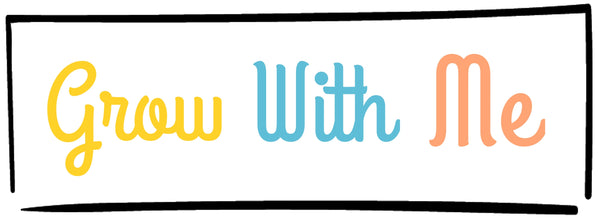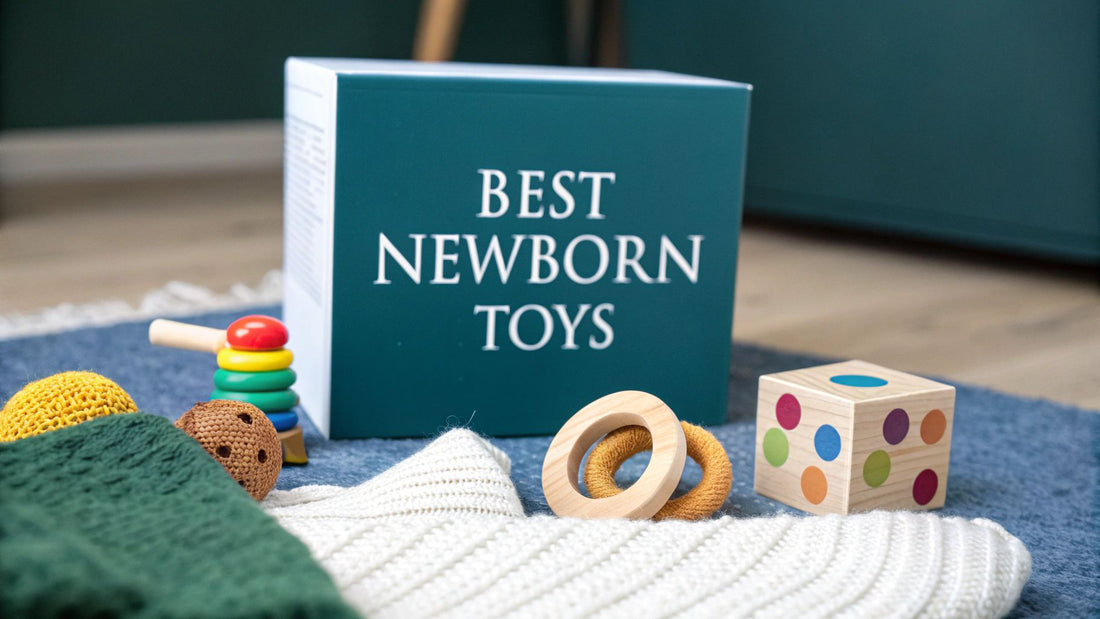
The Best Toys for Newborn Development
Share
When it comes to toys for a newborn, the simplest choices are almost always the best. Forget the complex electronic gadgets for now. High-contrast cards, gentle rattles, and soft, textured rings give your baby the clear, direct sensory feedback their brand-new brain needs to start figuring out the world.
Why Simple Toys Are Best for Your Newborn
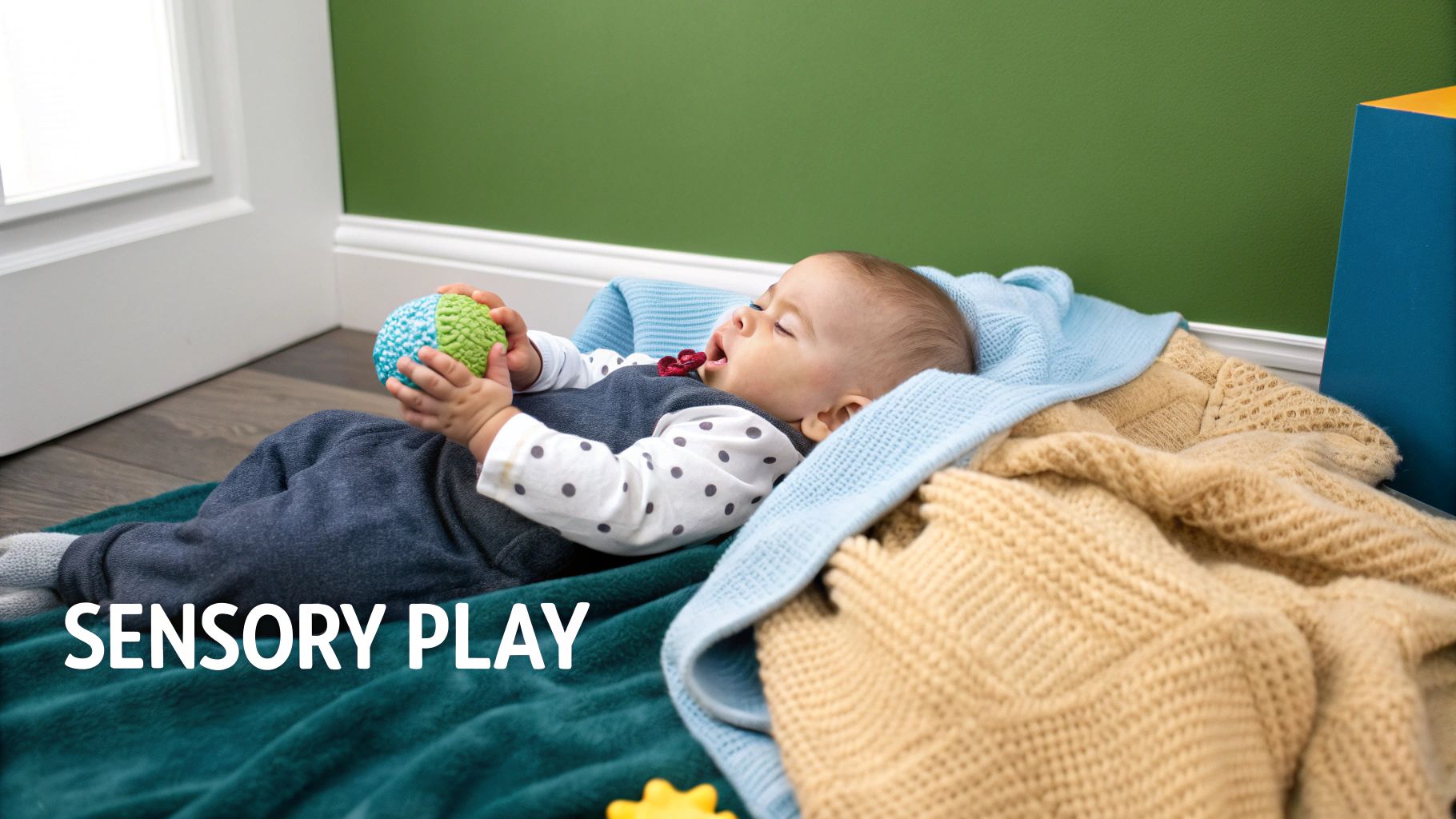
Bringing your baby home is an incredible feeling, and it’s completely natural to want to give them the very best of everything. But when you walk down the toy aisle, the sheer number of options promising to make your baby a genius can be dizzying. Here’s a little secret: the key to supporting your baby’s early development isn’t hidden in a toy with a dozen buttons and flashing lights.
Think of it this way: your newborn's brain is like a computer firing up for the very first time. It needs clear, simple data to build its core operating system. A toy that does too much—with flashing lights, multiple sounds, and movement—is like trying to run complex software on a system that's still learning to boot. It's just sensory overload. Simple, well-chosen toys provide the focused, manageable input their developing mind is truly hungry for.
Building The First Skills
The right toys are your baby’s first tools for discovery. They help them get to grips with the foundational skills that every other bit of learning will be built upon. In these first few months, everything is about mastering core sensory and motor abilities, and the best toys for newborn development are the ones that are designed for exactly that.
-
Visual Tracking: A newborn’s vision is still quite blurry. They can best focus on things about 20-30 cm away—which is, not coincidentally, about the distance from your baby's eyes to your face when you're holding them close. High-contrast toys, especially those with bold black-and-white patterns, are brilliant for grabbing their attention and encouraging their eyes to focus and follow movement.
-
Grasping Reflex: You’ve probably already noticed that your baby was born with an instinct to tightly grip anything placed in their palm. Lightweight rattles or soft rings are perfect for encouraging them to practise this reflex. This simple action starts building the hand strength and coordination they’ll need to start grabbing things on purpose a little later on.
-
Sound Recognition: A gentle, distinct noise helps your baby learn to work out where sounds are coming from. If you shake a soft rattle just out of sight to one side, you’ll encourage them to turn their head. It might seem small, but this is a huge step in developing their hearing and strengthening their neck muscles.
A newborn doesn't need a toy that does something; they need a toy they can do something with. The goal is to encourage your baby’s active exploration, not passive entertainment.
The Power of Connection
At the end of the day, your newborn’s favourite and most important "toy" is you. Your face, your voice, and your touch are the richest sensory experiences they can have. Simple toys aren’t meant to replace that one-on-one time; they’re meant to make it even better.
Shaking a rattle for your baby to hear or slowly moving a high-contrast card for them to follow creates these wonderful little moments of connection and shared discovery. These interactions are the absolute bedrock of their emotional and cognitive growth.
Choosing toys feels much less overwhelming when you shift your focus from a toy's features to its function. Instead of asking, "What does this toy do?", try asking, "What will this help my baby learn to do?". By prioritising simplicity and rich sensory feedback, you'll be giving your newborn exactly what they need to thrive.
For parents who want to take the guesswork out of finding the right things at the right time, a baby subscription box in the UK can be a brilliant option, delivering high-quality, age-appropriate toys right to your door.
When it comes to choosing the right toys for a newborn, the secret is to see the world as they do. Their brand-new senses are just starting to fire up, making their experience of sights, sounds, and textures completely different from ours. Getting on their level is the first step to picking playthings that will genuinely help their little brains grow.
Think of your newborn's vision like an old black-and-white film—it’s a bit blurry, and they can only really focus on things about 20-30 cm away (roughly the distance from your arms to your face). This is why simple, high-contrast patterns in black and white are so captivating for them. They’re the only "show" a newborn can properly tune into.
As this chart shows, the best toys change dramatically as your baby grows, moving from pure sensory discovery in the early days to more complex motor challenges later on.
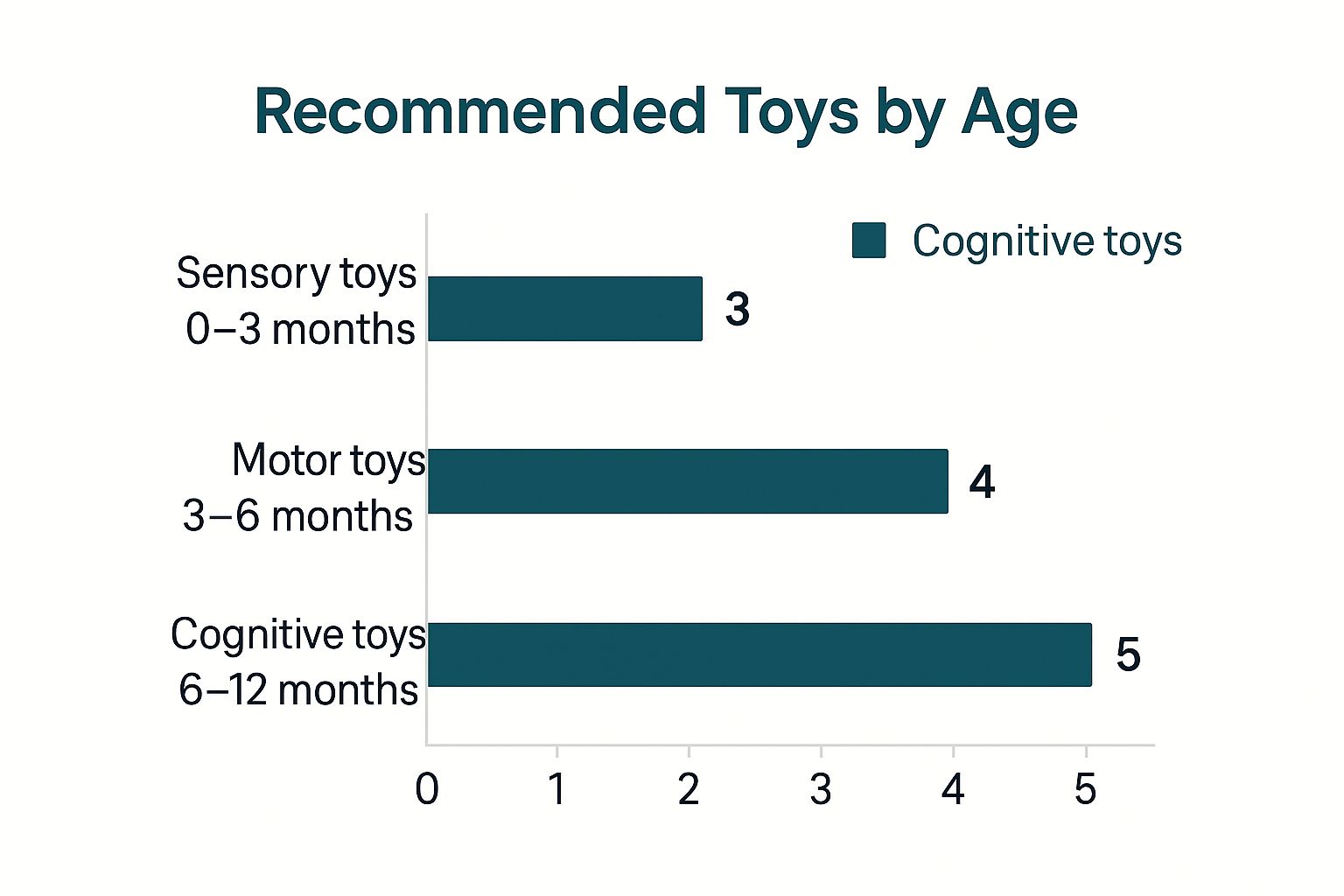
It all starts with sensory play, which lays the foundation for everything that follows.
Matching Toys to Their Senses
A newborn’s senses are the channels through which they learn absolutely everything. Our job is to provide just the right amount of stimulation—enough to be engaging, but not so much that it becomes overwhelming. It’s a delicate dance.
The table below breaks down what your newborn is capable of with each sense and which toy features best support their development.
Matching Newborn Senses to Ideal Toy Features
| Developing Sense | What Your Newborn Can Do | Ideal Toy Feature | Example Toy Type |
|---|---|---|---|
| Vision | Focuses on objects 20-30 cm away; sees bold, high-contrast shapes best. | High-contrast patterns (black, white, red); simple, uncluttered designs. | Play gym, soft contrast cards, board books. |
| Hearing | Startles at loud noises; turns head towards familiar sounds; soothed by gentle noises. | Soft, gentle sounds; consistent, predictable noises. | Soft rattles, crinkle toys, musical pull-toys. |
| Touch | Explores with hands and mouth; responds to different textures against their skin. | Varied textures (soft, smooth, slightly bumpy); easy-to-grasp shapes. | Cuddly toys, textured rings, fabric books. |
| Proprioception | Makes random, jerky movements with arms and legs; learns about their body in space. | Dangles within reach to encourage kicking and batting. | Activity mat with a play arch/gym. |
By thinking about play through this sensory lens, you can be sure you're giving your baby exactly what they need to make sense of their new world.
Hearing a World of New Sounds
While your baby’s hearing is surprisingly well-developed at birth, they're still learning to process everything. After months of listening to the muted, watery sounds of the womb, the outside world can feel loud and chaotic.
A soft, gentle rattle is perfect. It offers a predictable sound that encourages your baby to practise auditory tracking—the crucial skill of turning their head to find where a sound is coming from. In stark contrast, a loud electronic toy with flashing lights can be completely overwhelming for their still-developing auditory system.
The Power of Touch
For a newborn, touch is everything. It’s their primary language for feeling safe, loved, and connected to you. They learn about the world by feeling different textures with their hands and, of course, their mouths.
This is why offering a mix of baby-safe surfaces is so important:
- Soft fabrics offer comfort and gentle sensory input.
- Smooth wooden rings give them a firm, satisfying surface to grasp and chew on.
- Gently bumpy or crinkly textures send new and interesting information to their brain.
Every little touch is a piece of the puzzle, helping them figure out the physical world around them.
Discovering Their Own Body
Beyond the five senses we all know, newborns are also developing two internal senses that are absolutely fundamental for movement and coordination. These are the unsung heroes of your baby's first year.
One of the most important is proprioception—the body's awareness of itself in space. It's the "sixth sense" that tells your brain where your arms and legs are without you even having to look. Every seemingly random kick and flailing arm wave is your baby sending data back to their brain, slowly but surely building a map of their own body.
This is precisely why a simple play gym is such a fantastic tool. As your baby lies on their back, they might accidentally kick or swat at a dangling toy. That contact gives them instant feedback, teaching them a profound lesson in cause and effect. They start to realise, "Hey, my leg did that!"
These tiny, accidental movements are the very first steps towards intentional actions like reaching, grasping, and eventually rolling over. By giving them these opportunities, you’re helping them build the body awareness they need for every single motor skill yet to come.
Your Guide to Newborn Toy Safety in the UK
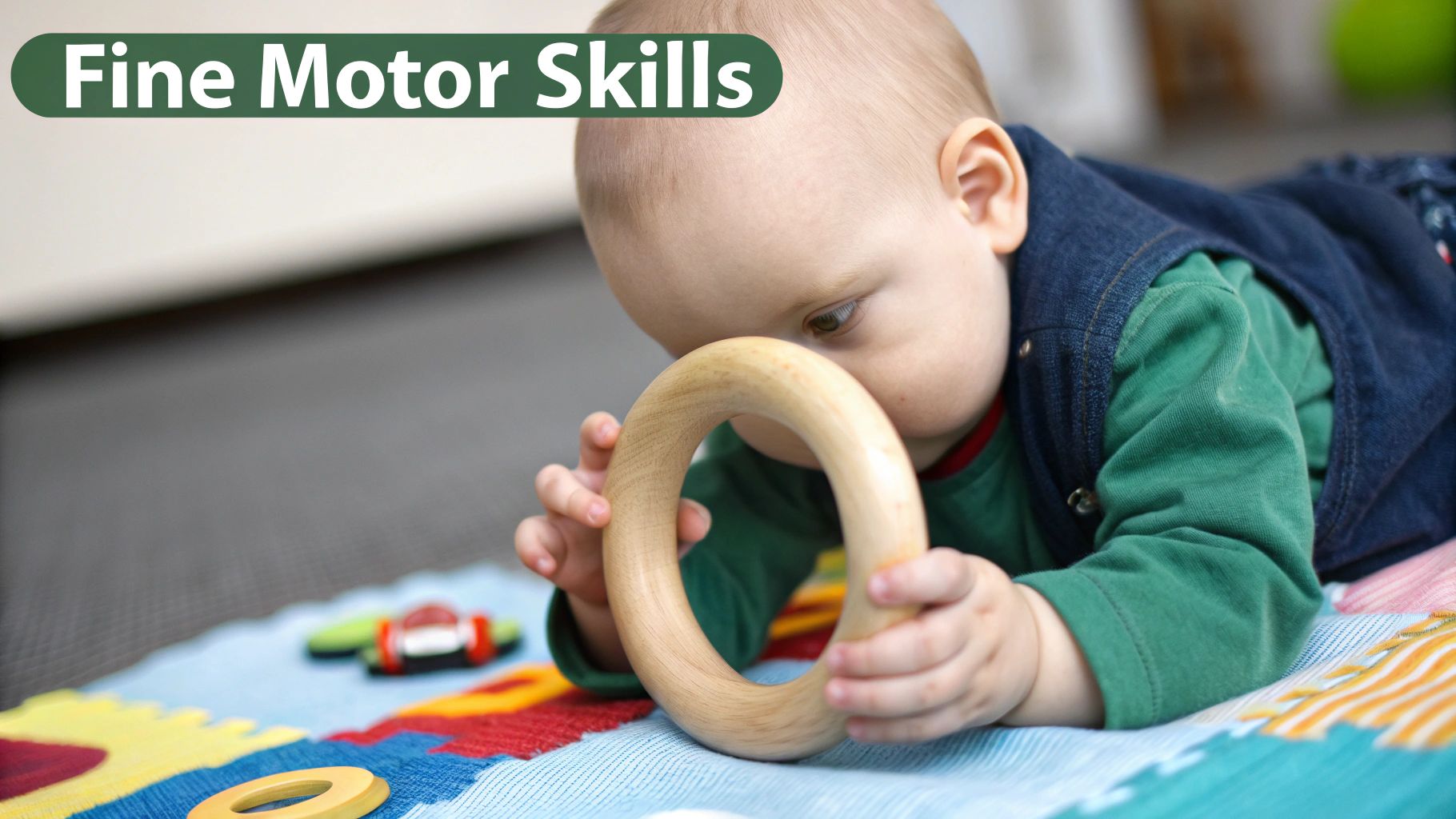
When you're picking out toys for a newborn, it's easy to get caught up in the colours and sounds. But before a toy can ever be fun or stimulating, it has to be one thing above all else: safe.
Safety isn't just another box to tick; it's the absolute foundation. A newborn explores the world with their hands and, most definitely, their mouth. That's why true peace of mind comes from knowing exactly what to look for—spotting the potential hazards long before they become a problem.
Decoding Toy Safety Labels
When you pick up a toy in the UK, your first port of call should be the label. Those little symbols aren't just for show; they're your guarantee that the toy has passed rigorous testing.
- The UKCA Mark: This is the big one. Standing for "UK Conformity Assessed," this mark is a legal must-have for most toys sold in Great Britain. It's the manufacturer's declaration that the product meets our stringent safety rules.
- The CE Mark: You'll likely spot this one, too. It shows a toy meets the health and safety standards for the European Economic Area. For now, it's common to see both marks on a single product.
Think of these marks as your first line of defence. If a toy doesn't have one, put it back on the shelf. It’s a major red flag that it may not have been safety tested at all.
Beyond the Label: Hands-On Toy Checks
While labels are crucial, nothing beats a quick physical inspection. Since your baby’s play is so tactile, you need to get a feel for the toy yourself.
Before handing anything new to your little one, give it a once-over with this checklist in mind:
- The Small Part Test: Are there any bits that could come loose? Think button eyes on a teddy bear or tiny beads inside a rattle. If a piece is small enough to fit inside a film canister, it's a potential choking hazard.
- Feel for Flaws: Run your hands over every surface. Check for sharp edges on plastic toys, splinters on wooden ones, and weak or fraying seams on anything plush.
- Check Cords and Ribbons: Any string or ribbon on a toy must be extremely short—no longer than 22 cm. Longer cords, which you might find on pull-along toys or mobiles, pose a serious risk of strangulation.
Crucial Safety Takeaway: A toy's safety isn't guaranteed forever. Regularly check your baby's favourites for wear and tear. Loose stitching, cracked plastic, or splintering wood can turn a beloved toy into a dangerous one.
The Invisible Dangers: Materials and Chemicals
Some of the most serious risks are the ones you can’t see. The reality is that unregulated toys, especially those from questionable online sellers, can contain chemicals that are particularly harmful to a newborn’s developing body.
This is where official regulations are so important. The UK Toys (Safety) Regulations 2011 set out the legal requirements for toys sold here, protecting children from hidden dangers like allergenic fragrances and harmful substances. They're designed with a baby’s behaviour in mind—like constant mouthing—and mandate clear warnings on packaging. You can read the full government guidance on toy safety regulations to learn more.
To keep your baby safe, be on the lookout for a few key things:
- Phthalates and BPA: Often used to soften plastics, these chemicals have been linked to health issues. Always opt for toys that are clearly labelled "BPA-free" and "phthalate-free."
- Toxic Paints: The paint on cheaply made toys can sometimes contain lead. Stick to trusted brands that use non-toxic, water-based paints, especially for anything that will end up in your baby's mouth.
By being a bit more vigilant, you can create a play space that’s not just fun and educational, but fundamentally safe. This lets you relax and truly enjoy watching your baby discover the world, one safe, happy playtime at a time.
The Hidden Dangers of Online Toy Marketplaces
The convenience of online shopping is a lifeline for new parents. With just a few clicks, you can have pretty much anything delivered right to your doorstep. But when it comes to buying toys for your newborn, that convenience can come at a steep price. The vast, often unregulated world of online marketplaces hides some very real dangers.
While big-name retailers usually have strict safety checks in place, third-party sellers on platforms like Amazon, eBay, and Wish can be a bit of a Wild West. These sellers might be based anywhere in the world, which makes it incredibly difficult to hold them to UK safety standards. This creates a loophole, allowing unsafe and even illegal toys to pour onto the market and into the hands—and mouths—of our most vulnerable little ones.
The scale of this problem is genuinely shocking. A recent investigation by the British Toy & Hobby Association (BTHA) put a range of toys bought from these platforms to the test. The results were alarming: 90% of the toys they tested were deemed unsafe for children, and an incredible 100% were illegal to sell in the UK. These weren't minor issues, either; the toys posed serious risks of choking, strangulation, and exposure to toxic chemicals. You can learn more by reading the full BTHA's online marketplace report.
A Cautionary Tale
Let’s paint a picture. A new parent, searching for the best toys for newborn development, spots what looks like the perfect wooden rattle. It’s from a seller they’ve never heard of, but the price is fantastic, and the pictures are lovely. When it arrives, everything seems fine. But after a few days of being gummed and shaken, a small bead works its way loose.
To a newborn, that tiny bead is an object of fascination, and its next stop is their mouth. In a split second, a sweet moment of playtime can turn into a terrifying choking emergency. This isn't just a scary story; it's the real-world consequence of buying unregulated toys online.
Your Digital Defence Strategy
So, how do you protect your baby? It’s all about becoming a bit of a digital detective, learning to spot the clues that separate a safe buy from a dangerous one.
Your first step is to figure out exactly who you're buying from. Is it the official brand, or a major, trusted retailer like John Lewis or JoJo Maman Bébé? Or is it a third-party seller with a generic name you don't recognise?
- Stick to the Source: Whenever you can, buy directly from the brand’s own website or from the online store of a high-street retailer you trust.
- Check the Seller Info: On marketplaces, always look for the "Sold by" or "Dispatched from" details. If it’s not the brand itself or the platform (e.g., "Sold by Amazon"), be extra cautious.
- Look for a UK Address: A proper business operating in the UK should have a physical address listed. If there are no contact details or only a non-UK address, that’s a massive red flag.
Think of the product listing itself as your next line of evidence. Unsafe toys often hide in plain sight, betrayed by shoddy listings, suspiciously low prices, and vague descriptions that skip over important details like materials and safety compliance.
How to Spot a Risky Product Listing
Even if the seller seems okay, the product page itself can tell you a lot. Before you even think about clicking "add to basket," give the listing a thorough once-over.
- Read the Reviews—Properly: Don't just glance at the star rating. Dive into the negative reviews first. Are parents complaining about parts breaking off, a weird chemical smell, or paint chipping away? These are all serious warnings.
- Examine the Photos: Are the pictures crisp and professional, or are they blurry, stolen from another site, or clearly computer-generated? Counterfeiters often use low-quality images.
- Check for Safety Marks: The product description or photos should proudly display the UKCA or CE safety marks. If you can't see them anywhere, it’s safest to assume the toy isn’t compliant.
- Trust Your Gut: If the price feels too good to be true, it almost certainly is. A toy that’s impossibly cheap has probably been made by cutting corners on materials, quality, and—most importantly—safety testing.
The Best Toy Categories for Newborn Development
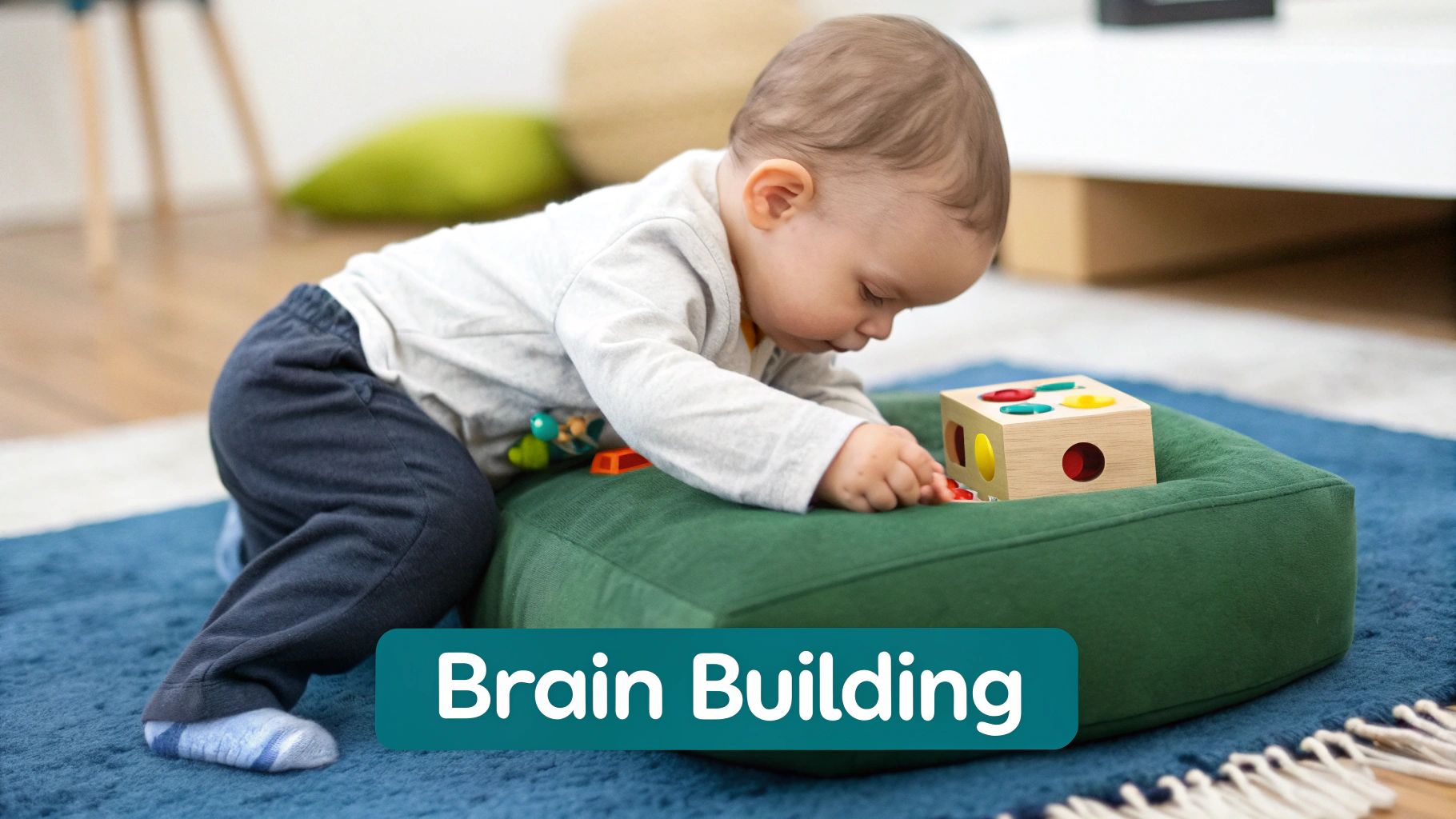
Alright, we've covered how a newborn senses the world and the absolute non-negotiables of toy safety. Now, let's bring that all together and look at the toys themselves.
When you're choosing the best toys for newborn development, it's not about finding one single "perfect" item. A better approach is to think of it like putting together a small, specialised toolkit. You don’t need hundreds of tools, just a few high-quality ones that are brilliant at what they do. Each type of toy is designed to nurture a specific area of your baby's growth, from wiring their vision to building those first hints of physical strength.
High-Contrast Toys for Visual Awakening
A newborn's vision is still a work in progress. Imagine seeing the world in soft focus, with a very limited colour palette. That’s why toys with bold, high-contrast patterns—especially in black, white, and red—are so incredibly powerful. They give a baby's developing eyes the clearest, most engaging information to lock onto.
These simple patterns do a surprisingly heavy-lifting job:
- Strengthening Eye Muscles: Following a slowly moving high-contrast card or gazing up at shapes on a play gym is like a tiny workout for their eyes, encouraging visual tracking.
- Increasing Attention Span: The stark contrast grabs and holds a baby's focus in a way that muted pastel colours just can't, helping them practise concentration.
- Stimulating Brain Development: Every time their eyes focus on these shapes, they're firing off strong signals to the brain's visual cortex, helping to build vital neural pathways.
Think soft fabric books with simple shapes, black-and-white flashcards, or a play gym with bold, dangling elements.
Sensory Toys for Tactile Discovery
From the moment they're born, babies use touch to make sense of everything. Their hands and mouths are their primary tools for exploration, constantly gathering data on different textures, shapes, and even temperatures.
This hands-on (and mouth-on!) exploration is fundamental to their cognitive growth. It's how a baby starts to categorise the world, learning the difference between soft and firm, smooth and bumpy. Offering a variety of textures helps them build a rich sensory library in their brain. For a deeper dive, check out our guide on the benefits of sensory toys for babies.
A simple set of textured rings or a soft book with crinkly pages might not look like much to us, but for a newborn, it's a full-body learning experience. Each new sensation helps them build a more detailed map of the world around them.
Auditory Toys for Sound Localisation
While a newborn's hearing is well-developed from birth, they still need to practise a skill called auditory localisation—which is just a fancy way of saying "pinpointing where a sound is coming from." Gentle auditory toys are perfect for this.
Unlike loud, electronic toys that can be overstimulating or even startling, a soft rattle or a musical mobile provides a predictable and pleasant sound. When you gently shake a rattle to one side of your baby's head, you'll see them instinctively try to turn towards the noise. This simple game is an excellent workout for both their hearing and the tiny muscles in their neck.
Motor Skill Toys for Building Strength
Newborns aren't reaching and grabbing with purpose just yet, but the right toys can encourage the random movements that lay the foundation for future motor skills. A simple play gym or activity mat is honestly one of the best investments you can make at this stage.
As your baby lies on their back, a toy dangling just within reach invites them to kick their legs and bat with their arms. Those accidental connections teach a powerful lesson in cause and effect—it's that lightbulb moment when they start to realise, "Hey, my body can make things happen!"
A baby-safe mirror placed on the floor during tummy time is another fantastic tool. Catching a glimpse of their own reflection can motivate them to lift their head, building crucial strength in their neck, shoulders, and upper back. This is the strength they'll need for all the big milestones to come, from rolling over to sitting up.
Choosing the Right Toy for Each Developmental Goal
Navigating the options can feel overwhelming, but breaking it down by function helps a lot. This table gives you a quick-reference guide to the main toy categories, what they're best for, and the key features to look for.
| Toy Category | Primary Developmental Benefit | Examples | Key Safety/Feature Checklist |
|---|---|---|---|
| High-Contrast Toys | Visual Stimulation & Tracking | Black & white flashcards, play gyms, soft fabric books | Bold, simple patterns; non-toxic inks; durable materials |
| Sensory Toys | Tactile Exploration & Cognitive Mapping | Textured rings, crinkle books, soft balls with varied surfaces | Baby-safe materials (e.g., food-grade silicone), no small parts, easy to clean |
| Auditory Toys | Sound Localisation & Hearing Development | Soft rattles, gentle musical mobiles, chime toys | Soft, pleasant sounds (not jarring); securely enclosed noisemakers |
| Motor Skill Toys | Strength Building & Cause-and-Effect | Play gyms, activity mats, baby-safe mirrors for tummy time | Stable base (for gyms), non-toxic materials, shatterproof mirror |
Ultimately, choosing a few well-designed toys that target these core areas is far more effective than having a room full of clutter.
With all toys, remember that quality is far more important than quantity. In the UK, the average child might own around 238 toys, but that number is meaningless if the items aren't safe or right for their developmental stage. Worryingly, some research has shown that a staggering 80% of cheaply made toys sold via major online marketplaces can fail basic safety standards, sometimes containing harmful chemicals that pose a real risk to a baby's developing systems. This makes choosing trusted, reputable sources for your baby's toys more important than ever.
How to Create a Nurturing Play Environment
So, you’ve picked out some wonderful toys for your newborn’s development. That’s fantastic. But the final piece of the puzzle—and honestly, the most important one—is the environment you create for play. Always remember, the most powerful developmental tool your baby has isn't a toy at all. It’s you.
Your voice, your touch, and your focused attention during playtime are what truly bring everything to life. These are the moments that transform a simple shake of a rattle into a profound brain-building experience.
The aim here is to build connection and spark curiosity, not to push for performance. A simple, safe spot on the floor is perfect. A soft play mat, clear of clutter, gives your little one the freedom to wiggle, stretch, and eventually make those first attempts at rolling. This dedicated space becomes a cue for them that it's time to explore and have some special one-on-one time with you.
Making Tummy Time a Positive Experience
Let's talk about tummy time. We all know it's essential for building neck and upper body strength, but it's no secret that many babies aren't instant fans. The key is to make it a positive, shared activity.
Get right down on the floor with them, face-to-face, so they can see you. A baby-safe mirror or a high-contrast book propped up in front of them can also provide brilliant motivation to lift that little head. Reading aloud is another fantastic way to engage them; you can find some great ideas in our guide to the best board books for babies.
The most enriching play environment is one of connection, not perfection. Every baby develops at their own unique pace. Your role is to be a loving guide, celebrating their tiny efforts and enjoying the shared journey of discovery.
It's also easy for a baby to get overstimulated, which can lead to them becoming fussy and overwhelmed. A simple toy rotation strategy works wonders here. Just keep a small collection of 3-5 high-quality toys out at any one time.
Store the rest away and swap them out every week or so. This approach keeps playtime feeling fresh and interesting, and it allows your baby to explore each item more deeply without feeling overloaded by choice.
Frequently Asked Questions
Stepping into the world of newborn toys can feel a bit overwhelming, and it’s natural to have questions. Let’s clear up some of the common ones parents ask when picking out the perfect first playthings for their little one.
How Many Toys Does a Newborn Actually Need?
It’s so easy to get carried away and fill the nursery to the brim, but for a newborn, less is definitely more. Too many options at once can be overstimulating for their brand-new senses. The key is to focus on quality, not quantity.
A small, thoughtfully chosen collection of 3-5 high-quality sensory toys is all you really need. You can rotate them every few days to keep things interesting. This simple approach prevents your baby from tuning everything out and encourages them to really focus and explore each toy in turn.
When Should I Start Introducing Toys?
You can start with gentle sensory play almost immediately. In those first few weeks, remember that you are your baby's favourite "toy." Your face, your voice, and your touch are the most powerful and comforting forms of stimulation.
When it comes to actual toys, high-contrast flashcards are a great place to start. Hold them about 20-30 cm away from their face. Once you notice your baby becoming more alert and curious—usually within the first month—you can bring in a soft, lightweight rattle or place them under a play gym for some visual exploration.
Key Takeaway: The best advice is to follow your baby’s cues. When they start tracking things with their eyes and seem more engaged during their wake windows, that’s your sign they’re ready for some simple toys.
Are Second-Hand Toys Safe for My Baby?
Used toys can be a fantastic and eco-friendly choice, but safety has to come first. Many pre-loved items are perfectly safe, but you need to put on your detective hat and give them a thorough inspection before handing them over.
Here’s what to check for on every second-hand toy:
- Safety Marks: Look for the UKCA/CE mark to ensure the toy met UK safety standards when it was new.
- Wear and Tear: Check for any cracks, splinters, peeling paint, or loose stitching. Anything that looks fragile is a no-go.
- The Pull Test: Give every part of the toy a good, firm tug. Make sure nothing is loose or could break off and become a choking hazard.
- A Deep Clean: Always sanitise used toys with a baby-safe cleaner before playtime.
Bottom line: if a toy looks worn out or you have even the slightest doubt about its safety, it’s best to pass.
Ready to give your baby the best possible start with toys designed for their exact stage of development? Take the guesswork out of playtime and explore the curated play kits from Grow With Me.
